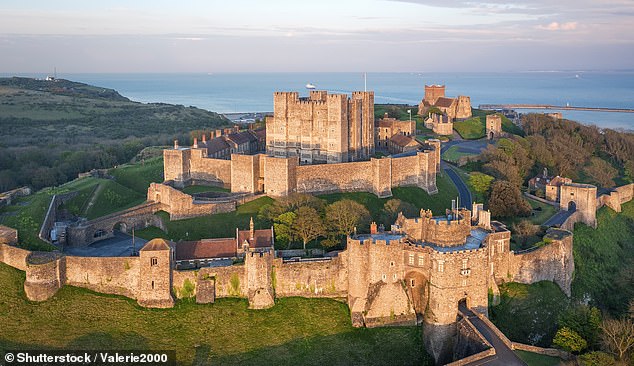Few places can transport you back and forth through our nation’s history like Dover Castle.
10am? It’s 1942, wide-eyed wandering through a World War II hospital buried deep beneath the White Cliffs, before visiting an underground network of war offices, where much of the Allied evacuation from Dunkirk was planned.
Time for lunch? It’s the 1180s, at the Great Tower, Henry II’s 80-foot-high centre of pomp and pageantry, with its 21-foot-thick walls and medieval furnishings, where my children, Bella, 12, and Cleo, 10, are trying to add chunks of meat to an exquisite-looking (wooden) stew in the kitchen.
Joanna Tweedy visits a new interactive family attraction at Dover Castle (above), called Dover Castle Under Siege. It tells the story of two sometimes forgotten attacks on King John’s kingdom in 1216 and 1217.


Dover Castle has two separate properties in which guests can stay: the 13th-century Peverell Tower, with one room (left and right), and the Sergeant Major’s House, sleeping six, which is reminiscent of the castle’s Georgian garrison days.
And now, I’m watching my lucky two get first dibs on a new playground with tunnels and the chance to fire a play version of a trebuchet catapult.
It is part of Dover Castle Under Siege, a new interactive, family-friendly attraction at the castle (included in the main admission price) that tells the story of two sometimes forgotten attacks on King John’s kingdom in 1216 and 1217.
These attacks, which were part of the First Barons’ War, saw French and English rebels lay siege to the castle.

Family fun: Tourists stroll around the moat, with the Constable’s Gate in the background

Joanna explores Henry II’s Great Tower, above, “an 83-foot-high centrepiece of pomp and pageantry with its 21-foot-thick walls and medieval furnishings.”
At its most brutal, there was a frenzy of chain-mail-clad knights and soldiers brandishing axes, swords and maces, with arrows flying and buildings burning.
Dover Castle Under Siege paints the picture with a spectacular interactive exhibition, access to the castle’s northern defences and a playground that puts young visitors right in the thick of medieval warfare.
Inside the exhibition there is the chance to fire a laser-beamed crossbow and then wander through defensive tunnels built after the siege, in some places medieval and roughly hewn, in others in neat Georgian brickwork.
The highlight of the tour is a visit to the Spur, the defensive barbican, which allows history buffs to see the castle for the first time through the eyes of the attackers, who faced death or victory.
There are two separate properties: the 13th-century, one-bedroom Peverell’s Tower and the six-person Sergeant Major’s House, which harks back to the days of the castle’s Georgian garrison.


